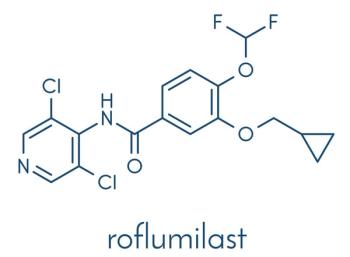
Dermatologic Lumps and Bumps
Would any of the 7 lumps and bumps here give you cause for alarm? Get an up-close look and a short lesson on each.
[[{"type":"media","view_mode":"media_crop","fid":"50535","attributes":{"alt":"","class":"media-image","id":"media_crop_3320134393411","media_crop_h":"0","media_crop_image_style":"-1","media_crop_instance":"6171","media_crop_rotate":"0","media_crop_scale_h":"0","media_crop_scale_w":"0","media_crop_w":"0","media_crop_x":"0","media_crop_y":"0","style":"height: 450px; width: 600px;","title":" ","typeof":"foaf:Image"}}]]
This picture of a 5-year-old boy's lip shows a cystic appearing lesion at the left lower lateral vermilion. It had been present for months and was asymptomatic.
It was elliptically excised in the office under local anesthesia and healed without complication.
Pathologic diagnosis was verruca vulgaris.
Differential diagnosis includes mucocele and inclusion cyst.
Next case
[[{"type":"media","view_mode":"media_crop","fid":"50536","attributes":{"alt":"","class":"media-image","id":"media_crop_8651257727643","media_crop_h":"0","media_crop_image_style":"-1","media_crop_instance":"6172","media_crop_rotate":"0","media_crop_scale_h":"0","media_crop_scale_w":"0","media_crop_w":"0","media_crop_x":"0","media_crop_y":"0","style":"height: 450px; width: 600px;","title":" ","typeof":"foaf:Image"}}]]
This 2.5-cm diameter rounded yellow cyst had been present on the right neck of a 33-year-old man for 3 years. It had gradually enlarged and was asymptomatic. A similar lesion at the same spot was incompletely excised just prior to the onset of the present lesion. He plans to have the mass removed in the near future.
This is an inclusion cyst, diagnosed from its clinical appearance.
Differential diagnosis includes abscess and nodular basal cell carcinoma.
Next case
[[{"type":"media","view_mode":"media_crop","fid":"50537","attributes":{"alt":"","class":"media-image","id":"media_crop_1129306988535","media_crop_h":"0","media_crop_image_style":"-1","media_crop_instance":"6173","media_crop_rotate":"0","media_crop_scale_h":"0","media_crop_scale_w":"0","media_crop_w":"0","media_crop_x":"0","media_crop_y":"0","style":"height: 450px; width: 600px;","title":" ","typeof":"foaf:Image"}}]]
An 83-year-old man presented with a cystic area at the acromioclavicular joint of the right shoulder; he reported no symptoms and that the lump had been present for many years. He had no history of injury that he could recall. It was an incidental finding on an examination prior to cataract surgery.
Plain film x-ray of the right shoulder revealed migration of the humeral head into the
subacromial space and indicated chronic rotator cuff disease. He required no treatment.
Differential diagnosis includes fracture of the distal clavicle and shoulder dislocation.
Next case
[[{"type":"media","view_mode":"media_crop","fid":"50538","attributes":{"alt":"","class":"media-image","id":"media_crop_6676512127165","media_crop_h":"0","media_crop_image_style":"-1","media_crop_instance":"6174","media_crop_rotate":"0","media_crop_scale_h":"0","media_crop_scale_w":"0","media_crop_w":"0","media_crop_x":"0","media_crop_y":"0","style":"height: 450px; width: 600px;","title":" ","typeof":"foaf:Image"}}]]
This picture of a 68-year-old man's left thumb shows a cystic lesion at the distal interphalangeal joint dorsum. It had been present for 1-2 months and was asymptomatic.
Clinical diagnosis is digital mucous cyst. They are benign ganglion cysts that usually arise from the distal interphalangeal joints of the fingers, and rarely the toes. The cysts are typically seen in adults aged 50 to 70 years and are associated with osteoarthritis.
Closely related is the digital mucoid pseudocyst, a collection of mucin in the dermis with fibrous stroma and no epithelial lining. When located proximal to the nail it may cause a nail groove which will extend the length of the nail.
Various treatments include: expression by pressure of the viscous fluid through needle holes, cryotherapy, steroid injection, sclerosant injection, electrocautery destruction, and surgical removal. Recurrence is not uncommon regardless of type of treatment.
After the patient was informed of the pros and cons of the various treatment modalities, he elected to forgo immediate intervention.
Differential diagnosis of digital mucous cyst includes digital mucous pseudocyst and bone tumor.
Next case
[[{"type":"media","view_mode":"media_crop","fid":"50539","attributes":{"alt":"","class":"media-image","id":"media_crop_2582936081674","media_crop_h":"0","media_crop_image_style":"-1","media_crop_instance":"6175","media_crop_rotate":"0","media_crop_scale_h":"0","media_crop_scale_w":"0","media_crop_w":"0","media_crop_x":"0","media_crop_y":"0","style":"height: 450px; width: 600px;","title":" ","typeof":"foaf:Image"}}]]
A slightly raised, light tan, 0.5 x 1.5-cm oblong lesion is noted on the post-auricular area of the left ear of a 58-year-old man. He stated it had been present for one month. He thought he had scratched the area with the arm of his sunglasses and it felt a little swollen compared with the right ear. It is located at the superior part of the ear.
The lesion was removed in the office with elliptical incisions under local anesthesia and healed well.
Pathologic diagnosis was Jessner's lymphocytic infiltrate (benign cutaneous lymphocytosis) completely excised. Stains for acid fast bacteria (Fite), fungus (GMS), and PASH were negative.
An immunohistochemistry panel was consistent with a reactive and non-neoplastic lympheral infiltrate.
This uncommon condition occurs predominately in men, but also in children and can be familial. It is a chronic benign T-cell infiltrative disorder with an unpredictable course; average duration is 5 years. Etiology is unknown. There may be recurrences in the same or other areas.
Depending on the location of the lesion treatment options are: local excision, topical and intralesional corticosteroids, antimalarials, photochemotherapy, and radiotherapy.
Differential diagnosis includes skin cancers, lupus erythematosus and other connective tissue diseases, mycosis fungoides, and leprosy.
Next case
[[{"type":"media","view_mode":"media_crop","fid":"50540","attributes":{"alt":"","class":"media-image","id":"media_crop_8715809838229","media_crop_h":"0","media_crop_image_style":"-1","media_crop_instance":"6176","media_crop_rotate":"0","media_crop_scale_h":"0","media_crop_scale_w":"0","media_crop_w":"0","media_crop_x":"0","media_crop_y":"0","style":"height: 450px; width: 600px;","title":" ","typeof":"foaf:Image"}}]]
This picture of a 13-year-old boy shows a rounded swelling, 1.5-cm in diameter, on the upper left eyelid. There are no signs of inflammation. This "bump" developed one week prior to this picture. He was asymptomatic.
Clinical diagnosis is chalazion. He was treated with hot compresses and it resolved over 2 weeks.
A chalazion, also knonw as internal hordeolum or meibomitis, is a lipogranulomatous cystic lesion of meibomian (sebaceous) glands, usually at the upper eyelid. It is typically sterile, but can become secondarily infected (usually staphylococcal).
Conservative treatment with hot compresses, with or without antibiotic drops, may be tried initially. If unsuccessful then surgical excision is indicated. This is an office procedure done under local anesthesia of the eyelid with topical anesthesia drops to the eye. After applying a chalazion clamp and inverting the eyelid a linear incision is made over the cyst and the contents are gently curetted.
Differential diagnosis includes stye, which is usually a bacterial; infection of the ciliary follicles or accessory glands of the eyelids (aka external hordeolum); orbital cellulitis; dacrocystitis; sebaceous cell carcinoma; basal cell carcinoma; squamous cell carcinoma, and other infectious etiologies.
Last case
[[{"type":"media","view_mode":"media_crop","fid":"50541","attributes":{"alt":"","class":"media-image","id":"media_crop_8987655763240","media_crop_h":"0","media_crop_image_style":"-1","media_crop_instance":"6177","media_crop_rotate":"0","media_crop_scale_h":"0","media_crop_scale_w":"0","media_crop_w":"0","media_crop_x":"0","media_crop_y":"0","style":"height: 450px; width: 600px;","title":" ","typeof":"foaf:Image"}}]]
This picture of a 54-year-old woman's elbows shows subcutaneous prominences. They were asymptomatic, unless bumped, and had been present for many years. They were diagnosed as rheumatoid nodules by a dermatologist a number of years before when she had active rheumatoid arthritis.
The only treatment was menthol cream typically for pain relief after being bumped.
Rheumatoid nodules are seen in about 25% of white males with rheumatoid arthritis. Women are less commonly affected. They range in size from 0.5-cm to many centimteres in diameter. Diagnosis is usually by clinical appearance, but biopsy may be necessary.
Treatment of the rheumatoid arthritis has no effect on the nodules which usually require no specific treatment unless they are on the hands or feet.
Back to first case
Newsletter
Enhance your clinical practice with the Patient Care newsletter, offering the latest evidence-based guidelines, diagnostic insights, and treatment strategies for primary care physicians.




















































































































































































































































































